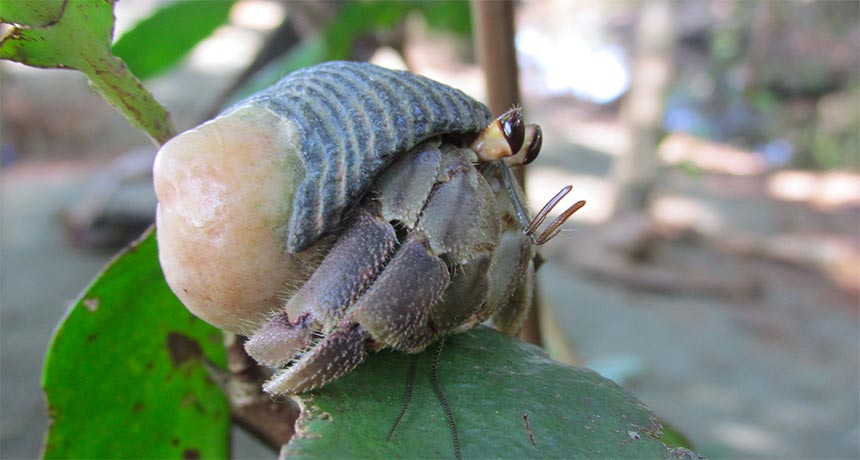Hermit crabs are drawn to the smell of their dead
Competition for abandoned shells soon turns into a lively party

Once a land hermit crab grows to the limit of its shell, it must find a bigger shell if it wants to grow more.
M. Laidre
By Yao-Hua Law
The death of a land-dwelling hermit crab always draws a crowd. Researchers working in Costa Rica now know why. They found that curious crabs are drawn to the smell of flesh torn from one of their own.
Hermit crabs live inside shells — homes that they carry around wherever they go. None of the roughly 850 known species of hermit crabs can grow their own shells. Instead, the crabs occupy shells originally left behind by dead snails. A hermit crab grows to the size of its shell. To grow beyond that size, the creature must track down a larger shell and move in. So as its home begins to feel crowded, a hermit crab has to somehow find an empty shell. It could be one vacated by a larger crab. Or it could be a shell left behind by a crab that recently died.
Mark Laidre is a biologist at Dartmouth College in Hanover, N.H. Leah Valdes was a student at the college. These two set up an experiment on a beach in Costa Rica. They set out 20 plastic tubes, each holding bits of hermit-crab flesh. Within five minutes, almost 50 hermit crabs (Coenobita compressus) swarmed each sample. “It’s almost like they were celebrating a funeral,” Laidre says.
In fact, the reality is more gruesome. That scent of flesh signaled that a fellow land hermit crab had been eaten. That also signaled there should be an empty shell for the taking, Laidre explains. The swarming crabs, he notes, “are all in an incredible frenzy to try to move into that leftover shell.”
Laidre and Valdes reported their findings in the February Ecology and Evolution.
M. Laidre
Just the right size
Finding a new home isn’t easy for a hermit crab. That’s especially true for the roughly 20 or so species that make their home on land. Aquatic hermit crabs can carry heavy shells because the buoyancy of water helps to lighten the load. So they can tote around a too-big shell without much trouble. But for land hermit crabs, big shells with lots of extra room to grow may be too heavy at first. Lighter shells may be too small. Like Goldilocks, these hermit crabs must find just the right fit.
Land hermit crabs can remodel their shells, Laidre reported in 2012. Scraping and use of corrosive secretions can widen a shell’s opening. The crabs also can expand the interior space by taking out the internal spiral and making the walls thinner. In the end, remodeling can double the available space while trimming one-third off a shell’s weight. But this home rehab is slow and takes a lot of energy. It’s far easier to just move into an already remodeled shell of some other land hermit crab. Hence the strong attraction of these animals toward smells that suggest another has died and vacated its home, Laidre says.
The researchers also found that land hermit crabs will approach bits of flesh from the snails that make those shells. That scent, though, appears to be far less alluring than that of their own species.
Sea hermit crabs, in contrast, didn’t find the smell of another hermit crab’s corpse more attractive than those of snails. This makes sense to Laidre. For sea hermit crabs, upsizing to bigger and heavier shells is relatively easy since they have a bigger range of shells that they can carry around. Plus, there also are many more empty shells in the sea than on land. That means that sea hermit crabs face less competition when scouting for a new home, he says.
Chia-Hsuan Hsu is an ecologist who studies hermit crabs at National Taiwan University in Taipei. By highlighting that shell availability is limited for land hermit crabs, the study makes an important argument for sea-shell conservation, Hsu says: “We can tell the public: ‘Don’t take shells from the beach.’”







